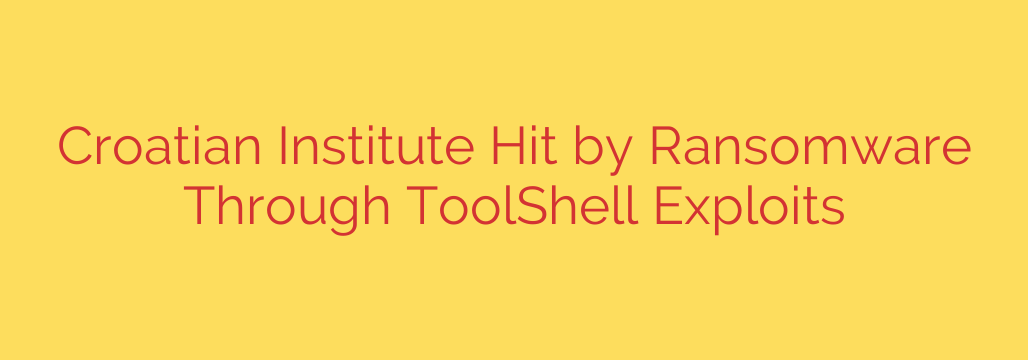
ToolShell Vulnerability: The Backdoor for Devastating Ransomware Attacks
Cybercriminals are increasingly exploiting a critical vulnerability in a legacy software component to deploy ransomware, leading to significant operational disruptions for organizations worldwide. A recent, high-profile attack on a major European public institute serves as a stark reminder that outdated software can provide an open door for sophisticated threat actors. The vulnerability, found within a component known as ToolShell, is being actively used to breach networks and deploy crippling ransomware.
Understanding this threat is the first step toward building a resilient defense. This article breaks down the ToolShell vulnerability, how attackers are using it, and the essential steps you must take to protect your network.
What is the ToolShell Vulnerability?
The core of this threat lies in a remote code execution (RCE) vulnerability tracked as CVE-2017-11317. This flaw exists in the Telerik UI for ASP.NET AJAX, a popular suite of user interface components for web applications. Specifically, the vulnerability is found in a file upload/download functionality within the framework.
While this vulnerability was first discovered and patched years ago, countless web servers across the globe remain unpatched. Attackers are now systematically scanning the internet for these vulnerable servers.
The danger of this vulnerability lies in its ability to allow an unauthenticated attacker to upload malicious files and execute arbitrary code on the server. This effectively gives them complete control over the compromised machine, providing a critical foothold inside the target’s network.
The Anatomy of the Attack: From Exploit to Ransomware
The attack chain is methodical and effective. Threat actors, including the notorious Abyss ransomware group, follow a clear pattern to turn this single vulnerability into a full-scale network compromise.
Initial Access: The attack begins with automated scanners searching for public-facing web servers running a vulnerable version of Telerik UI. Once a target is identified, the attacker exploits CVE-2017-11317 to gain initial access.
Establishing a Foothold: After executing the initial exploit, attackers often use legitimate remote management tools like AnyDesk or a Cobalt Strike beacon to establish persistent access. This allows them to maintain control even if the initial vulnerability is discovered.
Lateral Movement and Privilege Escalation: The compromised server becomes a launchpad for moving deeper into the network. The initial breach is just the beginning; the ultimate goal is to gain administrative credentials. Attackers use tools like Mimikatz to harvest passwords and escalate their privileges, eventually gaining control over the entire domain.
Ransomware Deployment: With full administrative access, the attackers deploy their ransomware payload. In recent incidents, the Abyss ransomware has been used to encrypt critical files across servers and workstations. The attack culminates in a ransom note demanding payment in exchange for a decryption key, leaving the organization paralyzed.
Actionable Steps to Secure Your Network
Protecting your organization from this and similar threats requires a proactive and layered security approach. Relying on a single line of defense is no longer sufficient. Here are the essential security measures you should implement immediately.
Patch and Update Aggressively: The most critical step is to identify and patch all instances of the vulnerable Telerik UI for ASP.NET AJAX. Assume you are vulnerable until you can prove otherwise. Conduct a thorough audit of all web applications and apply the necessary security updates provided by the vendor.
Implement Network Segmentation: A properly segmented network can contain a breach and prevent attackers from moving laterally. If an attacker compromises a public-facing web server, segmentation can stop them from accessing critical internal systems like domain controllers and backup servers.
Enforce the Principle of Least Privilege: Ensure that accounts and applications only have the permissions necessary to perform their intended functions. A web server should not be running with administrative privileges. Restricting permissions limits what an attacker can do even if they successfully exploit a vulnerability.
Conduct Regular Vulnerability Scanning: Don’t wait for attackers to find your weaknesses. Implement a continuous vulnerability scanning program to proactively identify and remediate flaws like CVE-2017-11317 and other outdated software components before they can be exploited.
Maintain a Robust Backup and Recovery Strategy: Ransomware’s power is its ability to hold your data hostage. A reliable, tested backup system is your ultimate safety net. Ensure you have offline and immutable backups that cannot be accessed or deleted by an attacker who has compromised your primary network.
The exploitation of legacy vulnerabilities like ToolShell is a powerful reminder that cybersecurity is not a one-time task but a continuous process. As threat actors refine their methods, organizations must remain vigilant, prioritize security hygiene, and build a defense-in-depth strategy to protect their critical assets.
Source: https://www.helpnetsecurity.com/2025/08/13/croatian-research-institute-confirms-ransomware-attack-via-toolshell-vulnerabilities/








